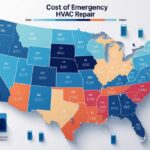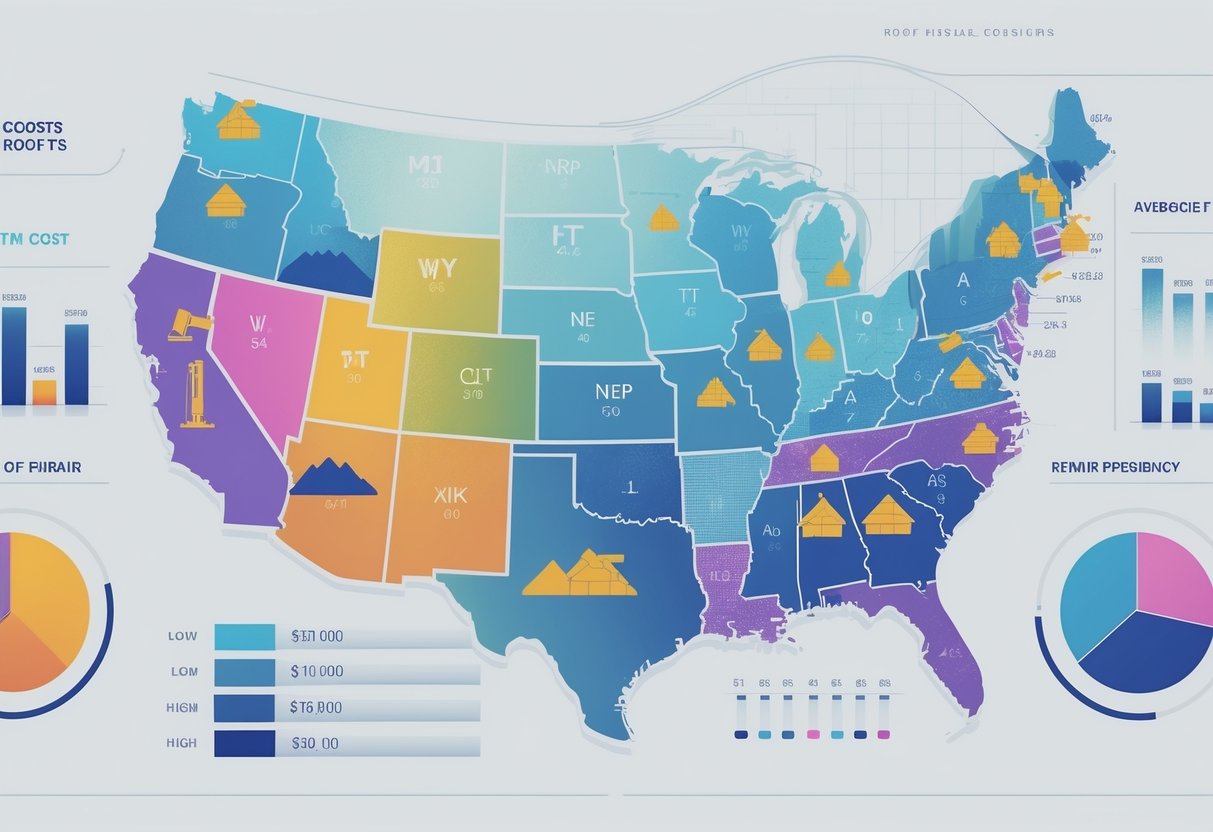Pest control costs swing wildly across the U.S. Homeowners might pay anywhere from $100 to $600 for a single treatment, all depending on where they live.
Regional differences in climate, pest types, and local labor rates make prices anything but predictable. If you’re budgeting for pest control, your ZIP code might matter more than you think.
Warmer states like Florida, Texas, and California usually have higher pest control costs. Year-round pest activity and a crazy variety of infestations drive up the price.
Colder northern states often get a break with lower prices. Seasonal pest slowdowns mean you might not need service as often.
Need a Home Fix – Emergency or Routine?
From leaks and no-heat nights to simple tune-ups, our 24/7 hotline connects you with trusted local pros in minutes.
Property size, treatment type, and local company competition all play a part in what you’ll pay. Termite treatments in the humid South? Rodent control in the city? Each region throws its own curveballs at homeowners and pest pros alike.
Key Takeaways
- Regional pest control costs run $100 to $600 per treatment—warmer climates usually charge more because pests never really quit.
- Property size and local labor rates make a noticeable dent in what you’ll pay from one city or state to the next.
- The treatment method and which pests are common locally will decide your final bill.
Understanding Pest Control Cost by Region
Prices for pest control really do change from region to region. Climate, pest populations, and even how many companies are in town all factor in.
Urban areas usually cost more than rural ones. States with warm weather? Expect to pay extra, since pests never really take a break there.
Regional Price Variations Across the United States
Florida, Texas, and California—these warmer states almost always have higher average pest control costs. Year-round pests and more frequent treatments are the norm.
States like Maine, Minnesota, and North Dakota? Colder weather means pest control is usually cheaper. Fewer bugs in the winter, fewer service calls.
Coastal states get hammered by moisture-loving pests. Florida and Louisiana, for example, deal with termites and mosquitoes way more often than drier areas.
Mountain and desert states—think Arizona, Nevada, Utah—land somewhere in the middle. They have their own pest problems, but not as many year-round headaches as the tropics.
The price gap between regions is real. A quarterly service in Florida might run $150-$250, while in Montana you could pay $100-$150 for the same thing.
Common Factors Influencing Cost Differences
Climate is the big one. Warm, humid places just have more pests and longer breeding seasons.
What pests are common locally changes the game. If you’ve got termites, you’ll need specialized (and pricier) treatments compared to just dealing with ants now and then.
How many pest control companies are nearby matters. In cities with lots of providers, prices tend to be more competitive. Rural spots with fewer options? Not so much.
Some states have strict regulations for pest control pros. More training and certification can bump up prices.
It’s no surprise that regions with higher living costs charge more for pest control. Higher wages and business expenses get passed right to the customer.
Spring and summer bring more pests—and higher prices. Demand just spikes when the bugs come out.
Key Cost Drivers in Urban vs. Rural Areas
Urban areas usually charge $150-$400 per visit. Higher costs, bigger demand, and more pest pressure come with city living.
Rural places often land between $100-$250 per treatment. Less overhead and competition can mean lower rates—or sometimes higher, depending on where you are.
Travel time can really bump up costs in rural areas. Companies might tack on extra fees for long drives between jobs.
Property size matters, too. Rural homes are often bigger, so they need more time and materials. Urban jobs usually cover smaller spaces, but infestations can be more concentrated.
Service availability isn’t the same everywhere. Cities offer more choices and specialties, while rural customers might have fewer options but sometimes get more personal service.
Emergency pest control in rural spots? Expect to pay more. Fewer providers and longer waits don’t come cheap.
Average Pest Control Prices by Region
Costs for pest control shift a lot from region to region. The Northeast usually tops the charts, thanks to higher living expenses, while the South deals with non-stop pest activity that keeps prices up, too.
Northeast
The Northeast has some of the priciest pest control bills in the country. One-time treatments in cities like New York or Boston can run $150-$350.
Annual services? You’re looking at $400-$1,200, depending on your home’s size and how bad the pests are. Living costs in the area push prices up fast.
Winter usually slows down the bugs, but rodents get bold. Mice and rats love to move indoors when it gets cold.
Termite treatments can get wild here. Homeowners might shell out $800-$3,000 for full termite control, especially when labor and equipment costs spike.
Midwest
The Midwest sits closer to the national average. A single treatment costs about $100-$250 for most homes.
Annual pest control runs $300-$800 across states like Ohio, Michigan, and Illinois. The climate keeps pests on a more predictable, seasonal schedule.
Spring and summer mean more calls for ant and spider treatments. Pest control companies get busy, and prices can nudge up.
Farm country faces its own battles. Rural properties sometimes need special treatments, which can push costs higher.
South
Southern states have to deal with pests all year, which definitely affects prices. One-time treatments usually cost $120-$280.
Hot, humid weather makes the South a paradise for bugs. Mosquito control alone costs $75-$150 per visit during the worst months.
Termite control is a big-ticket item here. Subterranean termites love the climate, so annual treatments are pretty much a must for lots of homeowners.
Monthly pest control isn’t uncommon in the South. Many folks pay $40-$80 every month just to keep up with the never-ending pest parade.
West
Out West, prices depend on where you are and what the climate’s like. California’s coastal areas can charge $130-$300 per visit, easy.
Desert regions have their own pest headaches—scorpions, spiders, weird desert bugs. Treatments get specialized and that can bump up costs.
Water rules in some western states change how companies treat pests. They might use more concentrated methods, which can mean higher bills.
Big cities like LA and San Francisco? Expect to pay 20-30% more than in the suburbs or countryside. Urban overhead just costs more.
Types of Pests and Regional Infestations
Every region has its own pest problems, shaped by climate and geography. The type of pest you’re up against can make a huge difference in what you’ll pay for treatment.
Most Common Pests by Region
Southern states battle termites constantly because of the warm, humid weather. Florida and Texas homeowners often pay more, thanks to termites, fire ants, and cockroaches. It’s a year-round fight down there.
Northern states deal with rodents when it gets cold. Mice and rats rush indoors for warmth, while bug problems slow down. Pest control here follows the seasons.
Western states have to handle unique ant species and desert pests. Think scorpions in Arizona. In California, strict rules can change which treatments you can even get—and what they cost.
The Midwest gets a bit of everything: insects in summer, rodents in winter. Termites aren’t as big a problem as down South, but every season brings its own pest headaches.
Insect Infestations and Costs
Termites are the real budget-buster. Treatments can cost anywhere from $225 up to $8,000, depending on how bad it is and how big your place is. Southern homeowners usually pay the most.
Bed bugs are another pricey pest. Treatments often run $1,000 to $5,000 per home. Cities everywhere deal with them, and you might need several treatments to wipe them out.
Ants? Not so bad, usually $150 to $300 per infestation. Fire ants in the South can push up annual costs if you need repeat visits.
Cockroach treatments cost $100 to $600. Warmer places get more stubborn infestations, especially in apartments and urban spots, so treatments can get extensive.
Rodent and Squirrel Control Expenses
Mice control usually lands between $200 and $600 for a full job. Demand jumps up north in fall and winter. If you need to seal entry points, that’ll add to the bill.
Rat infestations cost more—think $300 to $800. City dwellers and folks near the coast often pay more, since rats can be relentless.
Squirrel removal can get expensive, running $300 to $1,500 if there’s damage. Wooded areas everywhere deal with squirrels, and attic repairs can really add up.
Rodent exclusion work adds $200 to $1,000 on top of treatment. Sealing up a home, especially an older one, can get pretty involved no matter where you live.
Treatment Methods and Their Regional Pricing
Pest control methods come in all shapes and price tags. Chemical treatments are usually the cheapest option, while heat treatments and fumigation cost a lot more. Baiting systems and integrated pest management fall somewhere in the middle, with prices shifting based on local pest problems and rules.
Chemical Treatments and Pesticides
Chemical treatments are the go-to for most people. One-time sprays usually cost $100 to $260 in most places.
Prices can jump if you’re in a state with strict rules—California and New York, for example. Southern states might charge less per visit, but you’ll probably need more visits.
Average chemical treatment costs by region:
- Northeast: $150-$300 per treatment
- Southeast: $120-$250 per treatment
- Midwest: $100-$220 per treatment
- West Coast: $180-$350 per treatment
Pesticide prices also change with product availability and even shipping costs. Rural areas sometimes pay more, since there are fewer companies and longer drives for technicians.
Heat Treatments and Fumigation Costs
Heat treatment and fumigation services come with premium price tags, mostly because of the special equipment and training involved. Heat treatments usually run $300 to $1,500 per room, while whole-house fumigation can hit anywhere from $1,200 to $8,000.
Climate and service availability drive up regional price differences. In hot places like Arizona or Texas, you might find better heat treatment deals since the infrastructure’s already there. Colder regions? Expect higher rates for these services—no surprise there.
Fumigation costs by region:
- High-cost areas: $3,000-$8,000 per home
- Moderate-cost areas: $2,000-$5,000 per home
- Lower-cost areas: $1,200-$3,500 per home
Urban areas usually have more competitive pricing, thanks to the higher density of providers. If you’re out in the country, though, travel surcharges for fumigation can get hefty.
Baiting Systems and Integrated Pest Management
Baiting systems and integrated pest management (IPM) blend a few treatment methods for longer-term results. These programs usually cost $300 to $900 a year for a typical home.
IPM needs ongoing check-ins and custom plans. Local pest species and seasonal swings bump up regional prices. If pests are active year-round, continuous monitoring can get pricey.
IPM program costs by region:
- Urban areas: $400-$900 annually
- Suburban areas: $300-$700 annually
- Rural areas: $250-$600 annually
Setting up a baiting system usually costs $200 to $600, depending on your home’s size and the type of pest. Termite baiting especially needs trained pros, so if certified folks are scarce in your area, expect to pay more.
Professional vs. DIY Pest Control Costs Regionally
DIY pest control usually costs $20-$50 per treatment across the country. Professional services, though, range from $100-$550 per visit, depending on where you live. Labor, local rules, and pest pressure all play a part in these price swings.
DIY Solutions and Price Comparison
DIY pest control products land between $20-$50 for most treatments, no matter where you are. Oddly enough, rural hardware stores sometimes offer better prices than their city counterparts.
Common DIY picks:
- Ant baits: $8-$15
- Rodent traps: $10-$25
- Insect sprays: $12-$30
- Termite bait stations: $30-$50
Geographic price differences for DIY stuff are minor. Ant spray in Texas? Pretty much the same price as in New York.
Professional pest control prices swing a lot more by region. In the Northeast, it’s usually $150-$300 per visit. Down South, you might pay $100-$250. Out West, rates hover between $120-$280.
| Region | DIY Cost | Professional Cost |
|---|---|---|
| Northeast | $20-$50 | $150-$300 |
| South | $20-$50 | $100-$250 |
| West | $20-$50 | $120-$280 |
| Midwest | $20-$50 | $110-$260 |
When to Hire a Professional Exterminator
Exterminator services make sense when DIY just isn’t cutting it or things get out of hand. Regional pest pressure definitely influences this call.
In humid states like Florida or Louisiana, termites are relentless. Folks there usually end up calling in the pros sooner than those in drier areas.
Pest control companies tend to charge more where:
- Labor costs are high
- Licensing rules are strict
- Pest pressure is intense
- Homes are bigger than average
Big infestations—think termites, bed bugs, or a serious rodent problem—always need professional help. DIY just won’t cut it for those, no matter where you live.
Fixing pest damage can cost thousands, so bringing in professional pest control often saves money in the long run compared to endless DIY attempts.
Role of Pest Control Companies and Services
Pest control companies set prices based on local market factors. Cities with higher costs of doing business usually have steeper rates than rural spots.
National chains stick to more standardized pricing, with a few tweaks for local costs. Local outfits might offer better flexibility but sometimes have smaller service areas.
Pest control services generally cover:
- Initial inspection and treatment
- Follow-up visits
- Warranty coverage
- Emergency callbacks
Licensing rules in each state can really drive up pest control pricing. Tighter regulations mean more training and compliance costs for companies.
Competition shapes prices, too. More providers in an area usually means better deals for homeowners.
How often you need service changes by region. Southern states see more frequent treatments, sometimes monthly, while up north, quarterly service is often enough.
Additional Factors Affecting Pest Control Pricing by Region
Home size, service frequency, and prevention strategies all play into what you’ll pay for pest control. These factors work together, no matter where you live.
Home Size and Accessibility
Home size is a big deal when it comes to pest control costs. Bigger houses just need more materials and take longer to treat.
A 1,500-square-foot place usually runs $100-$260 for a one-time treatment. Go over 3,000 square feet and you’re looking at $200-$400.
Multi-story homes bump up labor costs. Technicians have to check basements, attics, and crawl spaces, which takes extra time.
Hard-to-reach spots cost more, too. If your home has:
- Narrow crawl spaces
- High ceilings
- Dense landscaping
- Lots of entry points
Expect to pay an extra $50-$150. Ranch-style homes are usually less expensive to treat than multi-level ones.
Frequency of Service and Maintenance Plans
General pest control plans lower the per-visit price compared to one-offs. Monthly plans cost $40-$70 per visit, while quarterly ones go for $75-$225 per visit.
Annual maintenance plans offer the most savings. Typically, you save 20-30% over paying for single treatments.
How often you need service depends on local pest pressure. Down South, monthly treatments are common during busy seasons. Up North, quarterly service usually does the trick.
Plan perks often include:
- Lower per-visit cost
- Priority scheduling
- Free callbacks between visits
- Seasonal treatment tweaks
Payment options vary. Some companies let you pay monthly for quarterly service, which helps spread out the cost.
Prevention Measures and Long-Term Savings
Pest prevention steps can cut future treatment costs by $100-$300 a year. Simple fixes really add up.
Effective prevention measures include:
- Sealing cracks and gaps
- Fixing leaks and moisture
- Getting rid of food sources
- Trimming back plants from your house
Good prevention makes professional treatments work better. Homes with solid prevention need fewer emergency visits.
Regular maintenance keeps infestations from getting expensive. Termite damage can cost $3,000-$8,000 a pop, but annual prevention is only $100-$300.
Combining prevention with professional service gives you the best bang for your buck. You spend less overall and get better year-round protection.
Frequently Asked Questions
Your region really does shape pest control pricing across the U.S. Homeowners notice big differences based on their state, city, and even the size of their place.
How does regional location affect the cost of pest control services?
Where you live changes pest control costs because of climate, local pests, and living expenses. Warm states like Florida and Texas usually charge more—about $150-$300 per quarter—since pests stick around all year.
Colder states like Maine or Minnesota see lower rates, usually $100-$250 quarterly, because harsh winters keep pests at bay.
Cities cost more than rural areas. New York might charge $152-$423 per service, while a smaller city like Jacksonville could be just $51-$141.
What are the average pest control prices for residential properties across different states?
Most states charge $100-$400 for quarterly residential pest control. The size of your home makes a difference, too.
Homes under 1,000 square feet typically cost $100-$200 per visit. Medium-sized homes (1,000-2,500 square feet) run $150-$300.
Larger homes—over 2,500 square feet—often pay $200-$400 per service. States like California, New York, and Massachusetts are pricier, mostly because everything costs more there.
Can you expect to pay more for commercial pest control compared to residential services?
Commercial pest control is just more expensive, period. Businesses pay $50-$500+ a month, depending on the size and how often they need service.
They need bigger treatments and regular check-ins. Plus, there are health codes to meet and special equipment to use.
Restaurants and food businesses pay the most. Offices and shops usually fall somewhere in the middle.
How has the cost of pest control services changed in recent years across the nation?
Pest control costs have gone up steadily over the past few years. One-time visits now run $250-$600, higher than before.
Monthly services have climbed to $40-$70 in most places. Annual plans usually cost $400-$1,000, depending on where you are and what you need.
Labor shortages and pricier chemicals have pushed costs up. There’s also more demand for eco-friendly treatments, which can be more expensive.
What factors contribute to the varying pest control prices near me?
Lots of local factors affect pest control pricing. Climate sets the stage for pest activity and how often you need treatment.
More pest control companies in your area usually means lower prices. Competition is good for your wallet.
Older homes or tricky construction often mean more work and higher costs. Newer homes are sometimes easier (and cheaper) to treat.
Labor costs and licensing rules matter, too. States with higher wages or stricter requirements tend to charge more for pest control.
Are there typical price ranges for one-time pest control visits?
Most people pay between $250 and $600 for a one-time pest control visit. The exact price? It usually depends a lot on which pest you’re dealing with.
If it’s just ants, you might pay anywhere from $100 up to $300 for a single treatment. But if you’re unlucky enough to have bed bugs, the cost can jump to $300—or even as high as $1,000 in some cases.
Termite jobs are all over the place in terms of price. Some might cost $225, while others get up to $8,000, all depending on how bad the infestation is.
Rodent control lands somewhere between $150 and $500 for a one-time service. That’s the typical range, though things can shift a bit.
Bigger properties or more severe infestations almost always mean higher bills. And if you need help on a weekend or in an emergency, expect some extra charges tacked on.







Leave a Reply